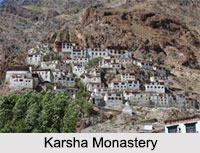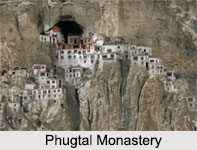 Perched in the Himalayas and surrounded by Zanskar plateau and Suru River, the topography of Kargil district, Jammu and Kashmir is characterized by craggy peaks, steep slopes, narrow gorges and deep valleys. The land is the centre of religious generosity. The land is the abode of a number of Buddhist monasteries. Temples of prehistoric origin blend well with the Buddhist monasteries while increasing the spiritual splendour of the place.
Perched in the Himalayas and surrounded by Zanskar plateau and Suru River, the topography of Kargil district, Jammu and Kashmir is characterized by craggy peaks, steep slopes, narrow gorges and deep valleys. The land is the centre of religious generosity. The land is the abode of a number of Buddhist monasteries. Temples of prehistoric origin blend well with the Buddhist monasteries while increasing the spiritual splendour of the place.
Cave Monastery
One of the popular monasteries in Kargil is the Cave Monastery that attracts pilgrims from all over the world due to its atypical constructional wonder. It is located at a distance of 35 km from Kargil on NH 1D. Cave Monastery stands stately, popping out of a brown cliff and looks like a hanging settlement in the middle of the mountains. The monastery is adorned with fine frescoes dedicated to the Lord Avalokiteswar. There is a Buddhist nunnery beneath the monastery. Cave Monastery is also known as Shargul Monastery.
Shargole Monastery
Another monastery of Kargil of almost similar feature is Shargol Monastery. The monastery gives the appearance of a hanging abode from the centre of the mountain on which it is located. Shargol Monastery houses ancient and mesmerizing images and frescoes that are worthy of the eyes of the beholder.
Mulbekh Monastery
Another gompa of Kargil is Mulbekh Gompa. Reining the neighbouring valley, Mulbekh Monastery is a high-flying place for Buddhist believers. This gompa is situated at a distance of 25 km of Bodh Kharboo on NH in the Zanskar Valley. The Mulbekh monastery is festooned with frescoes and statues, housing even some prized relics.
 Zongkhul Monastery
Zongkhul Monastery
This monastery, built in a cave, is located 20 km south of Rangdum. Zongkhul Monastery is engraved with beautiful frescoes by the monks. This gompa is mainly associated with Naropa, who was an Indian saint. It is believed that Naropa, while meditating in the caves, met Lord Brahma.
Sani Monastery
Sani Monastery is located in the central part of Zanskar Valley. This gompa was built by the Emperor Kanishka, who had 108 chortens constructed during the 1st century AD. Sani Monastery is considered as one of the eight holiest Buddhist sites in the world and the monastery has acquired the designation of Turtot Gyat. Many of the noted inspirational personas of Himalayan Buddhism including Padma Sambhava, Naropa and Marpa visited this monastery in search of divinity.
Phugtal Monastery
Phugtal Monastery is a fine example of cave monastery, which was initially built for meditation. This monastery is one of the most distant monasteries located in Lungnak Valley. Phugtal Monastery has become one of the most popular tourist destinations among people for its exquisite view, especially for solitude lovers.
Lamayuru Monastery
This monastery is situated in the east of Fotu La on the Srinagar-Leh highway. Lamayuru Monastery was built in 10th century, at a height of 11,000 feet. Indus River flows by the monastery. This monastery is often claimed as a Bon Monastery (pre-Buddhist religion), which was built on the original site of a lake. But later it receded after receiving Dalai Lama"s blessings.
Karsha Monastery
Karsha Monastery is the largest monastery in Zanskar. It was constructed out of whitewashed blocks. Having a vivid backdrop of the hills near Doda River, this gompa presents astounding views of the surroundings. It has many chapels and rooms for the monks. On the top of the hills, there is a nunnery which has a sacred image of 11 headed Avaloketeshvara.
 Other Important Monasteries of Kargil
Other Important Monasteries of Kargil
Braving the demanding climb, pilgrims visit the Stongdey Monastery which houses countless temples, which are reminiscent of the region`s monastic heritage. Several other monasteries in Kargil serve as a place of religious importance along with the place from where nature can be enjoyed. Belonging to the Drukpa Kagyupa order, the Stagrimo Monastery offers a splendid view of the passing vale due to its momentous location.
Among the other monasteries in Kargil, Starrimo Monastery is a branch of a greater monastic organization and was built in the 10th century. Some of these monasteries are of great historical importance like the Sani monastery. Pibiting Monastery is assumed to have been built by King Kanishka and is noted for its wondrous `stupa` creation. Rangdum Monastery is another popular name which showcases many sacred and interesting artifacts of Tibet. The monasteries in Kargil are the centers of practicing religious tasks, the study centre for the students and the abode of the educated monks.




